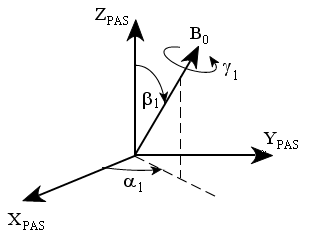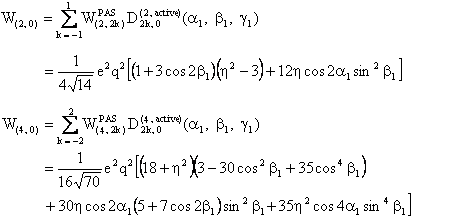EFG tensor for static crystal
For static crystal, the orientation of the static magnetic field B0 in the principal-axis system (主軸坐標系) of the EFG tensor (XPAS, YPAS, ZPAS) is described with the Euler angles α1, β1, and γ1.

We provide a Mathematica notebook that calculates the component V(2,0) of the second-rank spherical tensor V:

We used to defining the quadrupole coupling ωQ in the first-order quadrupole interaction by the following expression:

with

The quadrupole coupling is defined experimentally by half the frequency separating two consecutive absorption lines of a single crystal. It is half that used by A. Abragam.
On the other hand, the two components W(2,0) and W(4,0) of the fourth-rank spherical tensor W are obtained using the following expression:

The expression of W(0,0) is simply:

We also provide Mathematica notebooks for calculating the two components W(2,0) and W(4,0):

The third Euler angle γ1 does not appear in the above two relations because B0 is a symmetry axis for the spin system.
Conclusion
In the above expressions, the asymmetry parameter η is associated with cos2α1. As a result, if we add π/2 to α1, η will change to -η . In other words, the passage from our convention for η to that used in the simulation program SIMPSON and vice-versa is the addition of π/2 to the Euler angle α1. [see J. M. Koons, E. Hughes, H. M. Cho, and P. D. Ellis; Extracting multitensor solid-state NMR parameters from lineshapes, J. Magn. Reson. A 114, 12-23 (1995)]
However, if a software allows us to change the sign of η, we should use this possibility instead of adding π/2 to the Euler angle α1.
